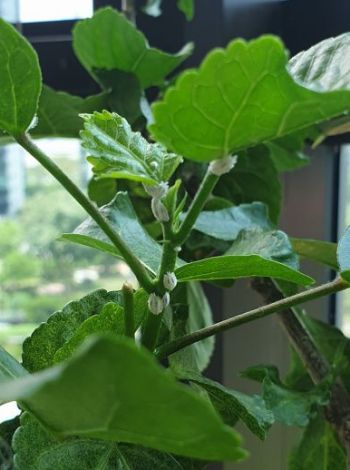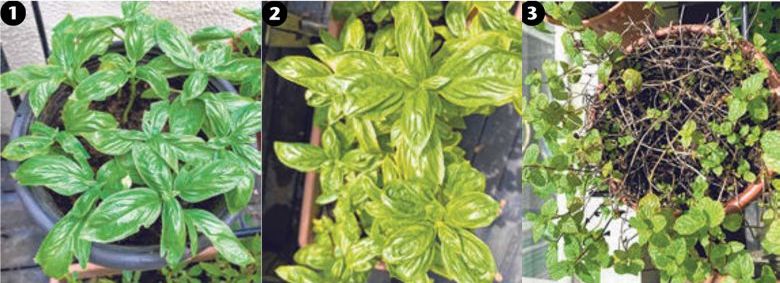Gardening FAQ #7 – What You Need To Know
In this article, we talk about mealy bugs and how to handle them. We also talk about nutrient deficiency and included a video on what you can do Let’s go through the common gardening FAQ, problems and solutions you need when growing your plants indoor and outdoor.
Jackfruit tree affected by mites or nutrient deficiency
 This four-year-old jackfruit tree produced its first round of fruit last year. Since then, the leaves have become ridged. What is the cause and how do I correct the problem?
This four-year-old jackfruit tree produced its first round of fruit last year. Since then, the leaves have become ridged. What is the cause and how do I correct the problem?
Distorted leaves in plants can be due to a number of reasons.
Microscopic mites, which are not visible to the naked eye and feeding on young leaves, can cause the leaves to develop abnormally.
If you have a high-powered magnifying glass, you can try looking for them in the creases of damaged leaves.
For such pests, you can spray neem oil or summer oil on young developing leaves to manage the population. Dilute the pesticide to avoid burning the foliage as young leaves tend to be more vulnerable to damage.
This could also be due to lack of certain nutrients, such as calcium, that are needed for growth.
Some nutrient deficiencies may be transient. It is necessary to ensure the growing conditions, such as soil moisture and fertiliser application, remain constant especially during rapid growth and flower and fruit production.
Ensure that the soil pH level is in the optimal range of your plant species and apply a layer of leaf mulch to conserve moisture and keep the roots cool. It also encourages beneficial soil biology that helps the plant absorb nutrients better.
The video below show you further ways to identify the leaf yellowing pattern and how to treat nutrient deficiency with the best fertilizer. You can also check out the 7 best fertilizers here.
Hibiscus has mealy bugs
 This hibiscus plant in my balcony has been infested with these pests. How do I get rid of them?
This hibiscus plant in my balcony has been infested with these pests. How do I get rid of them?
The cottony masses are mealy bugs, a type of sap-sucking pest. If the plant is attacked in large numbers by these pests, it can weaken and die.
To solve the issue, you can first use a jet of water to wash off adult pests.
Then spray a solution of summer oil or neem oil pesticide, which are organic pesticides with low toxicity, on all parts of the plant. It kills by suffocating the pests. Repeated applications are needed to keep the pest population in check.
Inspect the plants regularly and manage infestations – doing so reduces the likelihood of them spreading and becoming more severe.
Also, manage the population of ants in the growing area. Ants have a mutualistic relationship with mealy bugs and can bring the latter to your plants.
Basil may have leaf-eating pests and mint needs better growing mix

I grow herbs in my deck garden, which gets three to six hours of sunshine on sunny days. I noticed some of the leaves on my Italian basil look ripped or torn (Photo 1). Is it due to pests? I also noticed some plants have broader leaves and these plants are less bushy (Photo 2). Are the plants with broader leaves a hybrid? I also struggle to grow mint (Photo 3) in a steady and productive manner. I use shallow pots and organic fertiliser to encourage growth, but the results have been mixed. Similar to Italian and Thai basil, I leave them in the open so that they are exposed to plenty of sunshine. I also water them daily. I use good quality garden soil and compost, but with no sand. What am I doing wrong?
Your basil plants are likely damaged by a leaf-eating pest. You may find it beneficial to do a “night patrol” to see if you can catch the culprit.
If the damage bothers you, you may want to protect your basil plants by growing them in a fine netting tent, which will help to keep most leaf-eating pests out.
As for the elongated leaves and lankier growth habit, it appears to be an adaptation when sweet basil grows in tropical Singapore. It could be due to heat stress. The plant needs a cooler environment to thrive.
As for mint, an ideal growing mix is one which is well-drained yet moisture-retentive. A mix consisting of just compost may be too wet and not offer the needed aeration the root zone requires.
You may find it beneficial to add gritty materials such as fine expanded clay pellets or pumice into the mix to help open the growing mixture. Some gardeners incorporate burnt earth too.
Mint needs to be harvested often to promote new bushy growth. Stems left to grow may become old and the plant can lose vigour over time.